How Tolkien Disguised Ice-Age Europe as Middle-Earth
The Lost History of Middle Earth, Part 1
Maps of Middle-Earth have been laid over maps of Europe before. They’re never very interesting, because they seem to prove that Tolkien’s world was nothing close to a one-to-one representation of an ancient Europe. They usually place the Shire (per Tolkien’s instruction) at Oxford, but make no attempt to fit in anything else in a way that makes sense.
Here’s an Example:
Mordor is in the Mediterranean, the sea of Rhün is in the middle of nowhere, the misty mountains are in the ocean, etc. It seems an entirely fictional map of an entirely fictional world.
But if you know much about Tolkien, you know that his intent was to write European mythology, not “fantasy”. I never thought these map projections felt right. With the exception of the Shire, nothing ever looked to be in its proper place. I wanted to test if there is something more to his map-making, and his world of Middle-Earth that feels so real.
After doing this, I believe I can prove that Tolkien’s Middle-Earth is a map of Ice-Age Europe.
I did two things differently than most that have tried to overlay these maps.
Firstly, I decided to try a map of Ice-Age Europe instead of a modern map. Tolkien’s story is set in an ancient European pre-history, and must be set before the great floods and events that “changed all lands”. The map below shows Europe during the last glacial maximum, when the British Isles were still connected to the mainland by a landmass called “Doggerland”. The landscape shown in this map would have been the general look of Europe until around 6500 BC when Doggerland finished its gradual sinking into the waters.
Tolkien made estimations in his letters of how long ago his stories would have taken place, and the period before the sinking of Doggerland in 6500 BC does come close to his estimations.
Tolkien told us that the Europe of Frodo’s day looked very different from ours- "Those days, the Third Age of Middle-earth, are now long past, and the shape of all lands has been changed..."
The Ice Age landscape of Doggerland fits the bill perfectly.
The second thing I did was discard the normal scaling of Tolkien’s map, and lengthened and compressed it to fit the whole of Europe. I’m sure the professor would not mind, as he said himself that he knew the scale of Middle-Earth did not match Europe, and only by changing the scale in this way is it possible to see the true nature of his world.
For this to make sense then, I needed two definite geographic points in Europe. The first is the Shire, which Tolkien himself said it is around the latitude of Oxford.
In addition to this, I had to choose one more (and more defined) location for the map to work, or else I would just be sizing the map at random, and this whole article would be pointless.
The choice was easy- Osgiliath is Constantinople, on the land bridge between the East and West, between Greece and Persia, Gondor and Mordor. Tolkien could not have been more clear with this literary connection, so what could make more sense than to place Osgiliath there.
We also have some detailed instructions from the Professor. In his letters, he told us the latitudes of multiple locations. The Shire and Rivendell are to be at latitude with Oxford, Minas Tirith at latitude with Florence, the mouth of the River Anduin at the latitude of ancient Troy, etc.
Now that I had two definite points, the Shire in the general vicinity of the East of England, and Osgiliath at Constantinople, I was curious to see if the rest of the map would line up with the professors instructions and the broader geography of Middle-Earth.
Well, it did. Everything lined up in its proper place.
You’ll see that when this scale is used, Tolkien’s map matches the geography of Ice-Age Europe down to shockingly close detail. Even though certain areas like the southern coastlines have some issues, the accuracy of the map and its finer details will leave you convinced that something here beyond mere coincidence. All locations match the latitude instructions left behind by the professor.
Here is the map in its entirety. As I talk about specific regions, zoomed in pictures will be underneath the explanations.
The Shire is found in East England and Doggerland. The West and South farthings of the Shire touch the island of England, but the rest is in the now submerged lands. Bree, where Hobbits and Men lived together in peace, in right in the middle of this submerged land.
While there is a slight departure from Tolkien’s instruction that the Shire be on the same latitude as Oxford, it lands fairly close. (Oxford is located around 52 degrees North, and the Shire falls around 54 degrees North on this map.)
England makes up the region of Eriador just south of the Shire and north of the Brandywine River, as well as the region of Minhiriath.
The majority of Scotland, Wales, and Ireland make up the far Northwest regions of Eriador.
The Grey Havens stream out from the West coast of Ireland, and the blue mountains line up generally with the Scottish highlands.
The Southern Misty Mountains and the White Mountains of Gondor fall directly onto the alps, matching their shape almost perfectly as they spread out over Gondor/Italy. The northern Misty Mountains run from Austria, through Poland, and then swing back into Denmark, generally matching the traditional border separating Eastern and Western Europe. This fits in just right, as the Misty Mountains separate Tolkien’s Wilderland from Western Middle-Earth.
The coastal land of Gondor covers the lands of Italy and Macedonia underneath the Alps (or the White Mountains in Tolkien), and South Gondor covers Greece.
This placement matches the Professor’s instructions. Minas Tirith is on the latitude of Florence, and the mouth of Anduin is at the latitude of Troy.
Mordor falls on and is exactly the size as the bare and mountainous land of Turkey, where shadowy Eastern emperors would one day wage their great wars on the West.
Osgiliath, Minas Tirith, and Minas Morgul fall between these kingdoms on the land bridge, the site of future wars between East and West.
The Bay of Belfast leading out to the sea matches the Western half of the Mediterranean, though the Eastern half is missing here.
Mirkwood is located in the Slavic lands above Ukraine, which is exactly where it is attested to have existed by Norse sagas- in the strange, wild lands of the East. Omeljan Pritsak identified the Mirkwood in the Hervarar saga with what would later be called the "dark blue forest" and the "black forest" north of the Ukrainian steppe
The Atlakviða ("The Lay of Atli", in the Elder Edda) and the Hlöðskviða ("The Battle of the Goths and Huns", in Hervarar saga ok Heiðreks) both mention that the Mirkwood was beside the Danpar, the River Dnieper, which runs through Ukraine to the Black Sea. If you look at my map, you’ll see that Mirkwood lies in Ukraine and Belarus, above the Black Sea, and that the River Dnieper runs right through it, and in fact even meets with Tolkien’s River Running. (You can see the river run through Mirkwood through the town of Kyiv Knïb).
Rohan is found in the plains of Central Europe, mostly in the grasslands of Hungary between the surrounding mountain country, in fact it fits just perfectly into the land between the Alps (Misty Mountains), Carpathian Mountains, and the Balkan Mountains.
The Sea of Rhün falls directly on the Caspian Sea, with matching mountains to its southwest border. The river leading to Rhün from Tolkien’s Iron Hills is quite similar to the great Russian Volga River that winds down into the Caspian Sea.
Using this scale, the lands of Harad and Khand also actually match the Eastern lands they are meant to represent. Sauron calling them to war becomes a representation of the great armies of the Persian emperors marching against the West.
Even the tiny Icebay of Forochel lines up directly with a bay in the Northern landscape of Ice Age Europe. Compare the main bays and the smaller bays on the bottom left. Also notice the island “Himling” that Tolkien has included, similar in location to the Islands seen in the real Ice-Age landscape. It is one of the only islands included on Tolkien’s map.
Details like this shouldn’t be possible unless done intentionally. They certainly cannot be a coincidence. Why does Tolkien’s map include a tiny ice bay, one with little mention in his stories, that just so happens to math up perfectly with this ancient Ice-Age bay, long lost under the ocean?
Putting all the locations together, the map come out looking like this:
I think it is undeniable that this is the correct scale of Tolkien’s world, and that this proves that he was indeed writing a European mythology, not just a work of fiction.
I want to stress that this specific scale is the only way that this map works. The Shire must be on the East of England and in Doggerland, and Osgiliath must be on Constantinople. No other scale allows these things to line up altogether: the sea of Rhün, the Ice bay, Tolkien’s latitudes, the Alps and the Misty Mountains, or Mirkwood just north of the Black Sea. If you used any other scaling, or placed Osgiliath anywhere else, something would be off.
But what is the point of all this? Did Tolkien do this intentionally? Did he know the landscape of Ice-Age Europe, and mimic it? Is there more truth in his legends than we think? Did he somehow do all of this subconsciously, through his knowledge of myth and prehistory? Is it a complete coincidence?
I don’t know. This raises more questions than it gives answers.
I can think of two possible explanations, but neither explain everything.
The first is that somehow Tolkien knew the shape of Ice-Age Europe and did this intentionally, and withheld this secret from everyone. These is the most logical explanation, but it also seems unlikely, as he was incredibly open with the mythology he created in his letters and drafts. He is one of the most studied authors of all time. Further, the maps were created with the help of his son Christopher, who spent his life publishing his father’s unfinished works and writing countless pages on the history of Middle-Earth. If this had been done intentionally, we would probably know. Perhaps there is unknown information pointing to Tolkien being aware of and using Ice Age maps as inspiration that I have not found.
Another explanation is that Tolkien was more gifted than even his most passionate fans have believed, and his mythological and historical knowledge led to him creating something more real than even he realized. For example, Tolkien would have known the legends and history of the dark forest “Mirkwood”. He would have known the Norse sagas placed it above Ukraine. And as we know, Tolkien never wanted to “make up” anything- the mythological elements of his stories always followed their true history from European myth. So when Tolkien went to write his stories, he knew that Mirkwood lies in the East, beyond the mountains, because that is just where it goes. He may have placed it there without thinking much of it. While this would not do much on its own, Tolkien was a master of European mythology in its entirety, and if you apply this logic to his entire invented world, you can see how Tolkien could have unwittingly created a world that matched prehistoric ancient Europe.
But this explanation does not work very well either. You would expect this explanation to explain why his realms and landmarks are in the general locations and order that they are in- you would not expect them to literally fall on top of their real world counterparts. A map simply created as a representation of European myth could not possibly contain some of the details found here, and all of them lining up at the same time, in the same scale. You would expect maybe some things to line up- not all of them. Even if Tolkien was more of a genius than we realized, it does not explain details like the Icebay of Forochel.
Perhaps the answer is a mix of all of these theories, perhaps it is something entirely different. What is clear is that Tolkien, in his effort to write an ancient pre-historical European myth, actually succeeded in his endeavor in some sort of literal sense.
I believe that Professor Tolkien wrote mythology and history, legends of the great Ice-Age realms of Europe, realms that have now faded away into the dust and the deep, into our dimmest memories.

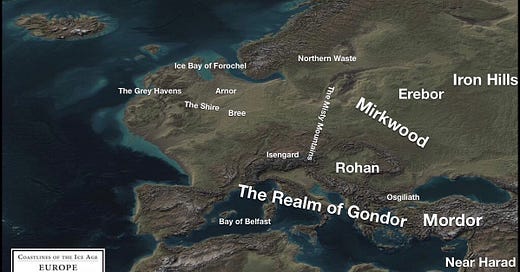









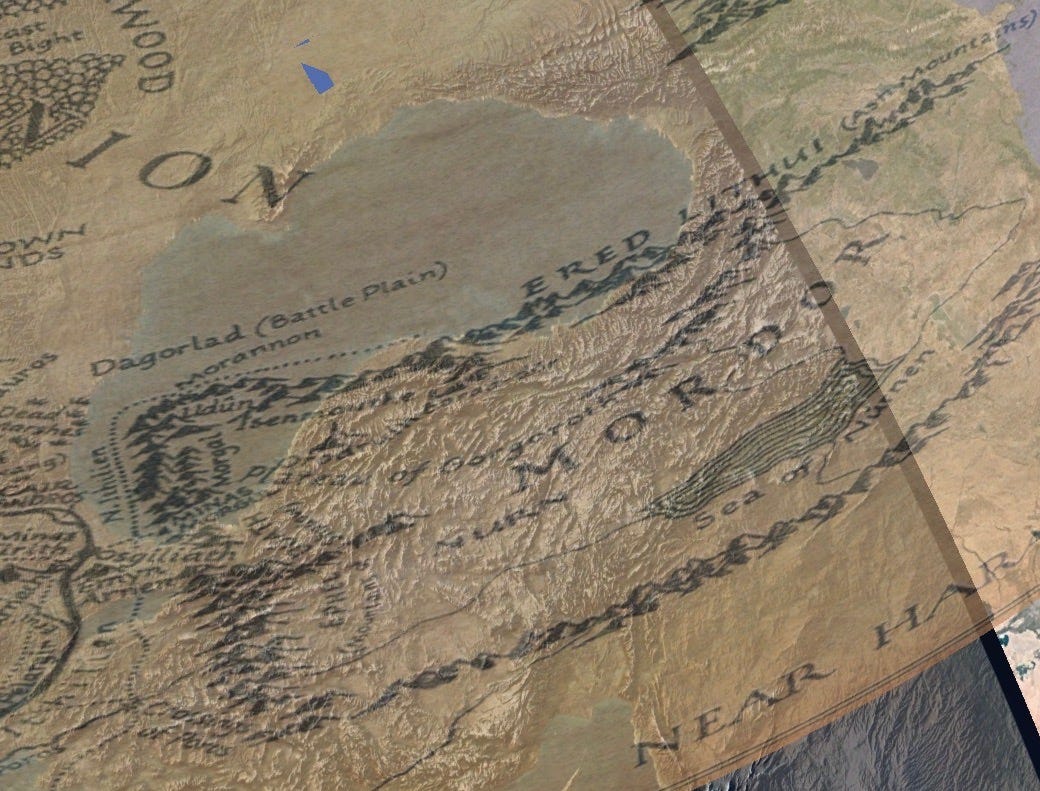
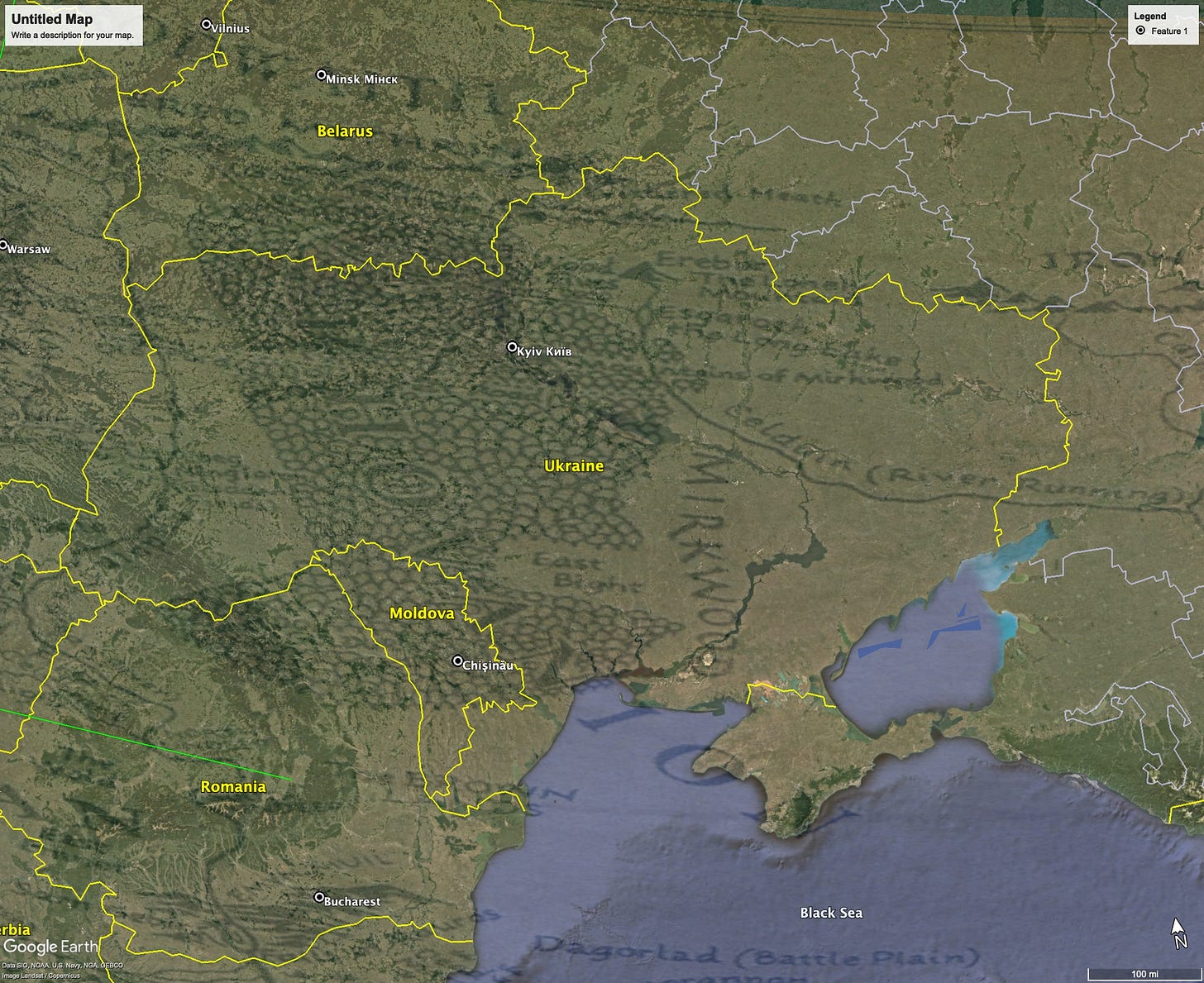



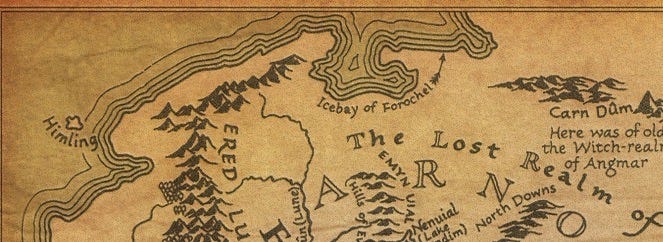


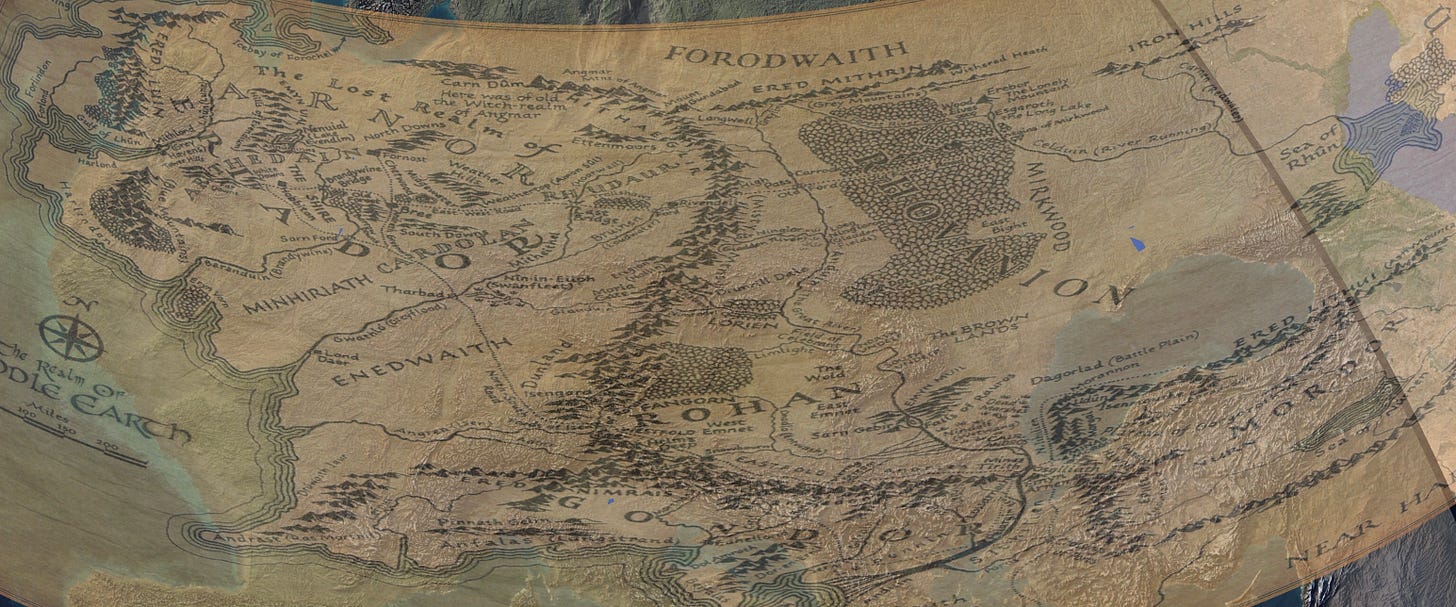
Doggerland was discovered in 1931 and caused a lot of excitement so I’m sure Tolkien would have been aware of it when he was writing LOTR.
Mordor corresponding exactly to the Caliphate of Ottoman Turkey also makes sense - the great scourge of eastern Europe almost prevailing at the Gates of Vienna were it not for the John III Sobieski of Poland and his winged Hussars cavalry whose charge broke the Ottoman ranks.